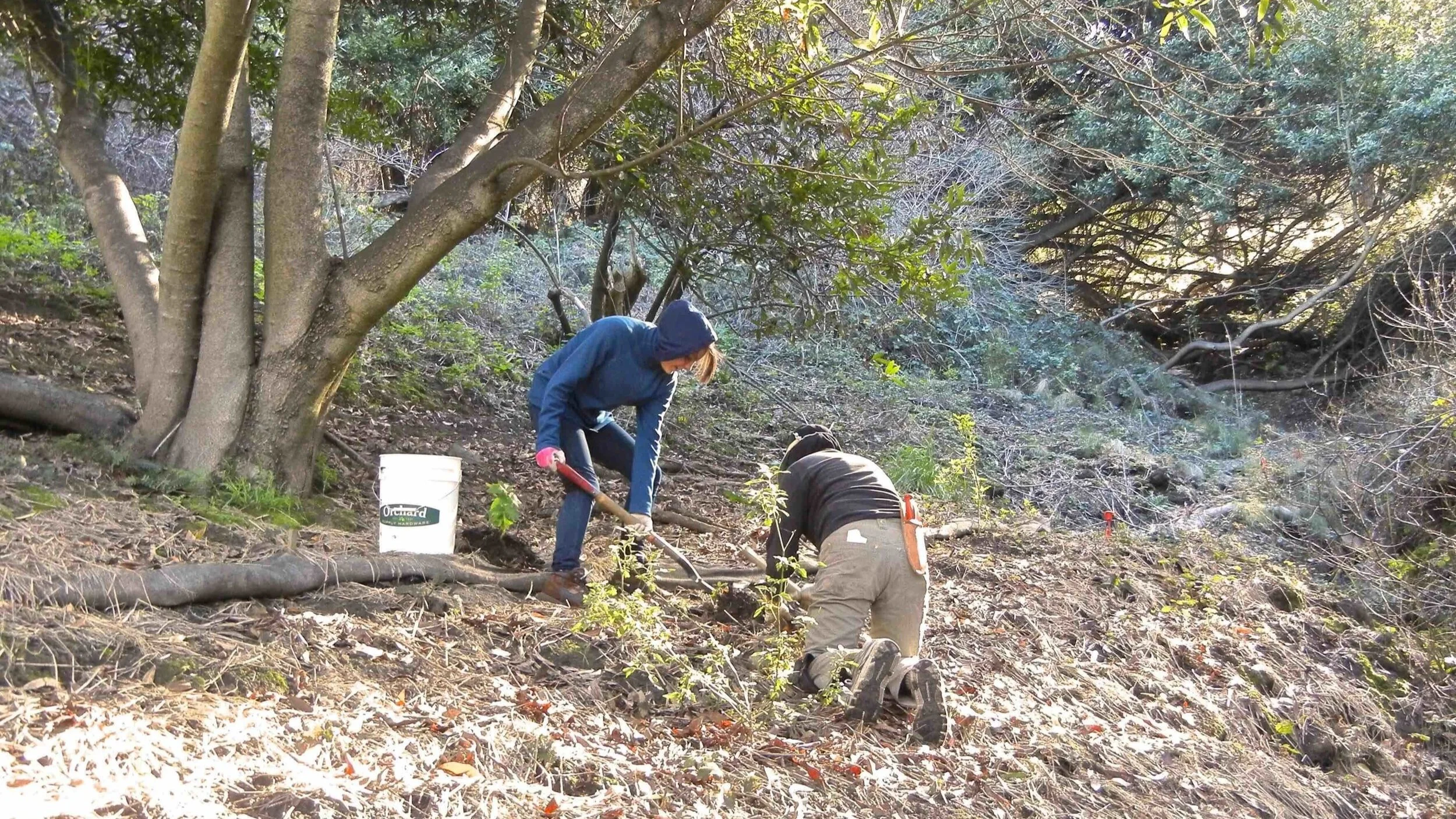To bird is to listen. And once you know the vocalizations of the local birds, an unusual bird stands out. That’s how Erica Rutherford and I discovered a summer tanager last fall in the Claremont Canyon Regional Preserve. Within minutes of stepping out of our car on the October 30, we heard “pit-ti-tuck,” a vocalization reminiscent of an expected (albeit out-of-season) species, the western tanager . . . but not quite. So, when we heard “pit-ti-tuck” again, we ran.
Managing a Changing Oak Woodland, by Shelagh Brodersen
Workshop attendees on the hillside planting native forbs and grasses after the removal of the old oak which had succumbed to “sudden oak death.”
THANKS TO EVERYONE who made January 12, 2019 such a fun and exciting start to this year’s restoration work in Garber Park. The recent removal of the old oak tree at the Evergreen Lane entrance, due to its earlier demise, gave way to a most timely, information-packed and fun workshop by Lech Naumovich. The workshop focused on the changing ecology of the Evergreen Hillside and was aptly named: Managing a Changing Oak Woodland: Oak Woodland Restoration Post-Climax.
The old oak came down on Thursday, January 10, the first sunny day after a week of down-pours, just in time for the weekend workshop. And what a fantastic workshop it was. From Lech: “ I estimate we planted over 100 plants (plugs, containers, cuttings plus we caged three coast live oak seedlings). What a great group and we got quite a bit of work done.”
May 6 bird walk—an ode to spring, by Kay Loughman
Especially with spring birding trips, our walk was as much about listening as seeing. We identified 29 species (see list below), many by sound alone. Resident singers, American Robins were among the first species we heard. Newly-arrived Swainson’s Thrushes announced their presence with single chips–they’ll be producing their spiraling ethereal song in another week or so. Then the “what peevesyou?” call of a distant Olive-sided Flycatcher let us know it too had completed its northward migration.
December 9, 2017 Bird Walk, by Kay Loughman
Last month's bird walk, led by Dave Quady and me, was a quiet affair—only fourteen species were observed over six hours of birding (minus 90 minutes for breakfast). That's an all time low for our winter bird walks, likely due to lack of rain (only one significant rainfall since spring) and strong dry winds the preceding week. Nevertheless our group of birders—four for the early morning owl walk and six for the after breakfast bird walk—enjoyed each others' company while we waited . . .
The wonders of Garber Park, by Nancy Mueller
if you haven’t delved into the wonders of Garber Park, you need to know about it! You will find a delightful native oak woodland with native fern grottoes, giant coast live oaks, California buckeyes, California big leaf maples, and a fascinating old defunct replace from old boy scout days of the 1920’s! All this is within walking distance from the intersection of Ashby and Claremont avenues.
Making a difference, Conservancy President Tim Wallace
Tim Wallace considers himself a “Yes man”—not a person that caves into other people's demands, but the kind that says, “Yes” to life.
Tim just celebrated 15 years (on and off—mostly on) as president of the Claremont Canyon Conservancy, "Working with volunteers we have helped make the canyon more fire-safe, more natural, and more accessible by trails.”
Tim has been involved with natural resources all his life: first as rancher and logger, then later in academics. He has been at UC Berkeley since 1963. "I've worked at the White House on agricultural matters and was Director of California's Department of Food and Agriculture. I've done consulting abroad in Europe, Latin America, Africa, the Far East, and New Zealand and Australia."
Big Cats in Claremont Canyon, by Janis Bankoff
A new study conducted by the East Bay Regional Park District reveals the presence of mountain lions (“Big Cats”), an elusive apex predator utilizing the wilderness ridegtop above the Caldecott Tunnel to transit between the open spaces north and south of the tunnel. The study, expanded earlier this year to include the Caldecott Tunnel Corridor, is led by veteran Park District wildlife ecologist and science consultant Steve Bobzie
Daughter fights fire, by Gerry Keenan
Newest Lichen for Claremont Canyon, by Kay Loughman
At the invitation of the Conservancy, in 2009 members of the California Lichen Society surveyed lichens at sixteen sites in Claremont Canyon. Read a report of the survey in the Conservancy’s Fall 2009 Newsletter. In all, 81 lichen species were identified. The results of the survey . . .
Winter Bird Walk with Dave Quady, December 11, 2016, by Kay Loughman
Alameda whipsnake/striped racer research project, by Jessica Sheppard
Claremont Canyon Regional Preserve is hosting a research project focused on the Alameda whipsnake (Masticophis lateralis euryxanthus), also sometimes referred to as the Alameda striped racer (Coluber lateralis euryxanthus). This elusive and speedy snake is protected at the state and federal level and may be found in the park.
Art installation features view from Claremont Canyon, by Marilyn Goldhaber
Spring in the canyon and update on fire safety work, by L. Tim Wallace
Keeping abreast of Claremont Canyon, by Marilyn Goldhaber
There are many ways to keep abreast of the goings-on in Claremont Canyon—and also in its surrounding neighborhoods. If you are interested mainly in the wildlands of Claremont Canyon and the activities of the Claremont Canyon Conservancy, including our hikes, stewardship projects, trail upkeep, and wildfire safety, we have a monthly one-page newsletter that we send out by email to our members and anyone else who signs up for the service.


